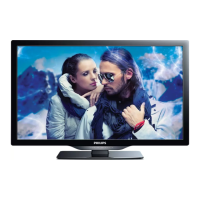
Do you have a question about the Philips 32PFL4907 and is the answer not in the manual?
| Screen Size | 32 inches |
|---|---|
| Display Type | LCD |
| Smart TV | No |
| HDMI Ports | 3 |
| USB Ports | 1 |
| Audio Output | 20 W |
| HD Type | Full HD |
| Aspect Ratio | 16:9 |
| Built-in Speakers | Yes |
| Speaker Output | 20 W |
| Number of HDMI Ports | 3 |
| Number of USB Ports | 1 |
| Power Consumption (Standby) | 0.5 W |
| Viewing Angle | 178 degrees |
Contact details for Philips Customer Care Center in various regions for assistance.
Explains important safety symbols like CAUTION and WARNING for risk reduction.
Provides advice on safely placing and using flat panel displays, especially around children.
Guidelines for safely mounting your flat panel display on a wall, emphasizing secure installation.
Numbered list of safety instructions for operating the apparatus, covering water, cleaning, heat, etc.
Specific instructions and warnings regarding the use of wall mount brackets and TV installation.
Details regarding FCC regulations, Canadian notices, and RF exposure statements for compliance.
Information on product warranty, pixel characteristics, and company trademarks.
Lists various copyrights, trademarks, and associated product acknowledgements.
Guidelines for safely positioning the TV and instructions for environmental care and battery disposal.
Repeats safety warnings regarding tilted furniture, ventilation, and gas dusters.
Details key features of the TV, such as DTV/TV/CATV, Net TV, Child lock, and various input options.
Lists supplied accessories like remote control and manual, and explains user manual symbols.
Step-by-step instructions for attaching the TV base, requiring two people for larger models.
Guides on routing cables neatly and installing batteries in the remote control for proper operation.
Detailed explanation of the function of each button on the TV remote control for easy operation.
Describes the physical buttons on the TV, their functions, and the infrared sensor for remote control.
Details all available input/output terminals on the TV, including HDMI, USB, Ethernet, and audio jacks.
Guides on connecting antennas, cable boxes, and other devices using RF, HDMI, or Component Video inputs.
Instructions on safely plugging in the AC power cord after all connections are made, with a caution.
Guides the user through initial setup, including language, country, channel scan, and network connection.
Explains how to adjust picture settings based on preference using test pictures during initial setup.
Instructions on saving preferences, handling network updates, and accessing post-setup features like Autoprogram.
Overview of available settings after initial setup, including language, country, network, and picture adjustments.
How to turn the TV on/off and adjust the volume level using the remote or control panel.
Methods for changing channels using number buttons, CH +/- controls, or PREV.CH function.
Guides on selecting external inputs and accessing the Home menu for device management.
How to lock/unlock devices and enable/disable remote control key forwarding for specific devices.
Instructions for installing and using MediaConnect to wirelessly display PC content on the TV.
How to play photos, music, and videos stored on DLNA servers via the home network.
Guides on listening to music and viewing photos via DLNA, including slideshow and transition options.
Explains how to play videos via DLNA, including playback controls, fast forward/backward, and resume functions.
Instructions for logging into Net TV, managing apps, and browsing the App Gallery for available services.
Steps for watching videos through vTuner, including playback controls and adding/removing favorite stations.
How to listen to internet radio, manage favorite stations, and add new stations via the vTuner website.
Steps for resetting station lists, creating new stations, adding user accounts, and understanding Pandora player screen.
Instructions for logging into Twitter, navigating the home screen, and viewing tweets on the TV.
How to view saved favorites, replies, created lists, and trending topics on Twitter via the TV.
Using auto mode for picture/sound presets and creating/managing lists of favorite channels for quick access.
How to set the sleep timer to automatically turn off the TV after a specified period.
How to change the picture format (aspect ratio) for 16:9, 4:3 signals, and PC input for optimal viewing.
How to display current channel, signal, and program information on the TV screen using the INFO button.
How to connect a USB memory stick to view photos, music, and videos stored on it.
Details the required file formats, codecs, and specifications for picture, music, and video playback via USB.
Explains how to play MP3 files from USB, including playback, repeat, shuffle, and audio settings.
Details how to play MPEG videos from USB, including playback, search, subtitle, audio language, and TV speakers settings.
Overview of the Setup menu and its main categories like Picture, Sound, Features, Installation, and Software.
How to set the picture format, mode selection, and auto adjustment for optimal picture quality.
Detailed guide on adjusting backlight, contrast, brightness, color, tint, and sharpness for personalized picture settings.
Fine-tuning advanced picture settings like color alignment, noise reduction, dynamic contrast, and MPEG artifact reduction.
Configuring digital audio language, analog SAP, and MTS/Stereo settings for optimal sound.
Explains SRS TruSurround XT, AVL, TV speakers output, and delta volume adjustments for enhanced audio.
How to configure digital caption service, including size, font, color, and background for text display.
Information on analog captioning services and different display modes for captions like Paint-on, Pop-on, and Roll-up.
How to lock programs or channels using PIN codes and TV/movie ratings for parental control.
Instructions on how to set the sleep timer to automatically turn off the TV after a specified period.
How to make specific channels or external input modes invisible using the channel lock feature.
How to set TV and movie rating locks to control program access based on age and content ratings.
Setting Canadian ratings locks and changing the default PIN code for security and parental controls.
How to change the on-screen menu language to English, Spanish, or Français.
Steps for performing Autoprogram, Weak channel installation, and general installation mode setup.
How to uninstall channels and reactivate removed channels if needed.
Configuring location settings for optimal performance and managing the E-sticker display.
How to use Philips EasyLink for one-touch play, standby, system audio control, and RC key forwarding.
Details on how EasyLink works, viewing connected devices, and configuring RC key forwarding and HDMI-ARC.
Guides on setting up wireless LAN or wired Ethernet connections for internet access.
Using the network settings assistant, selecting connection types, and performing a connection test.
Step-by-step guide for connecting to wireless networks automatically or manually entering SSID and security type.
Detailed steps for setting up IP addresses, DNS, proxy server, and other network configurations.
How to test the internet connection after configuring network settings to ensure proper functionality.
Procedures for resetting network settings to default and returning picture/sound settings to factory defaults.
Information on upgrading TV software for improved performance and checking current version.
Guides on downloading and installing software upgrades using USB memory stick or network connection.
Settings for Netflix/VUDU deactivation, checking Netflix ESN, and automatically checking for latest software.
Connecting devices via HDMI for highest picture quality, including HDCP and HDMI-ARC support.
How to connect devices using HDMI-DVI, Component Video, and Composite Video inputs for various quality levels.
Details on using HDMI-ARC for audio output and connecting Component Video for enhanced analog signal.
Instructions for connecting the TV to the internet using an Ethernet cable, including network setup and cable purchase advice.
Guides on setting up wireless LAN connection, and connecting PCs via HDMI, HDMI-DVI, and VGA.
How to connect the TV to external digital audio devices using a coaxial cable for multi-channel audio.
Lists the video signal formats and resolutions supported by the TV, including VGA, SVGA, XGA, WXGA.
Information on connecting and using a USB memory stick for playing pictures, music, and videos, with notes on compatibility.
Common questions and answers regarding remote control issues, initial setup, RF signals, and channel display.
Solutions for common issues like no power, no picture/sound, no color, and control button malfunctions.
Troubleshooting steps for problems like no screen image, distorted picture, poor sound, and display coverage issues.
Solutions for network connection failures, poor wireless LAN quality, and display issues related to captions.
Troubleshooting steps for wireless connection problems, streaming issues with Netflix, VUDU, Pandora, and MediaConnect.
Definitions of common TV terms (DTV, HDMI, HDTV, etc.) and instructions for servicing and IR signal checks.
Guidelines for cleaning the TV cabinet and panel, and information on when to seek professional servicing.
Comprehensive list of specifications for picture, sound, ease of use, connections, power requirements, and operating temperature.
Details the terms of the limited warranty, what is covered, and what is excluded, including limitations on liability.
Contact information and procedures for obtaining customer support and warranty service for the product.
Terms and conditions for copying, distribution, and modification of software under the GNU GPL.
License terms for using libraries, allowing linking with non-free programs under specific conditions.

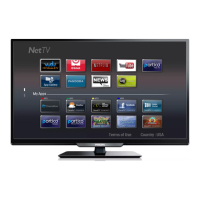
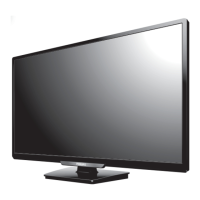
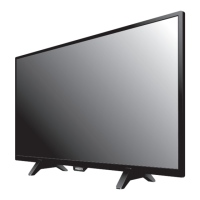

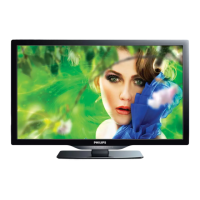


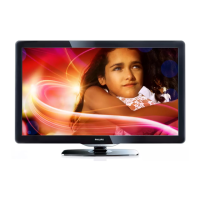



